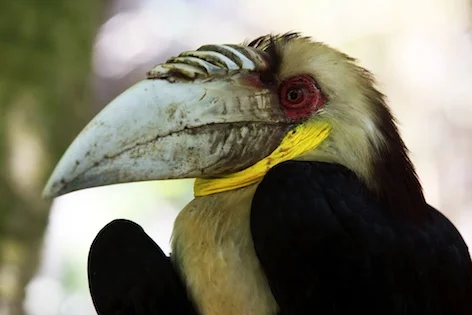Hornbills are odd looking birds.
There are many different kinds of hornbill.
Their beak is shaped like a big horn.
Some beaks have an extra horn on top.
The female hornbill blocks herself into a hole to nest.
The male feeds her through a small hole in the wall she makes.
The scientific name of the hornbill family, "buceros", means "cow horn" in Greek.
A great hornbill ©Getty Images
What are hornbills?
Hornbills are a family of birds that get their name because of their very distinctive bill. There are many species, or kinds of hornbill, in Africa and parts of Asia.
Habitat and distribution (where they are found)
Hornbills are found in tropical and subtropical Africa, Asia and parts of the Pacific islands, including the Philippines and Solomon Islands.
There are 24 species, or kinds, of hornbill found in Africa. About 13 of those are found in open woodlands and grasslands, others are found in thick forests and some in very dry areas.
In Asia, one species is found in open grasslands, and the rest are forest dwellers. Indonesia has 13 hornbill species, 9 of them in Sumatra. There are 9 species found in Thailand. There are 9 species found in and near India, and one species that is found only on the island of Sri Lanka.
A wreathed hornbill looks like it is wearing a wreath around its neck ©Getty Images
Appearance and Behaviours
Hornbills are a family of birds with long, often brightly coloured, beaks that curve downwards, sometimes with a horn-like part called a casque on the upper part of the beak. The casque is hollow or filled with a spongy material, and its purpose is not known. It is made of keratin, which is what our hair and fingernails are made of.
Males are usually larger than females , heavier and with a greater wingspan. The first two neck vertebrae are fused together, probably to help the bird bear the bill’s weight. They are the only birds to have this neck adaptation.
A pair of oriental pied hornbills ©Getty Images
Hornbills are diurnal, or active in the daytime. Hornbills cannot swallow food caught at the tip of the beak because their tongues are too short to move it, so they have to jerk their heads backwards to toss the food to the throat.
Diet
A plain-pouched hornbill ©Getty Images
Most of the forest-dwelling hornbill species are frugivorous, which means eating only fruit. The birds eat fruit, and the seeds emerge in their poo in a different part of the forest, so hornbills are an important way that seeds are spread far from the parent trees.
The species living in open grassland are omnivorous, and eat fruit, insects and small animals.
Life cycle
Rhinoceros hornbill ©Getty Images
Hornbills pair for life and return each year to nest in the same tree. Before nesting, the male offers the female a food gift and takes her to the nest site, a natural hole in the side of a tree or cliff face. The female then enters this hole and proceeds to block up the entrance with mud and droppings, whilst the male does the same from the outside. Only a very small hole is left open, large enough for food to be passed in and droppings to be passed out of the nest, but keeping the nest safe from predators. Larger species lay only two eggs, but smaller species may lay as many as eight eggs. Incubation varies according to species, but lasts for between 23 and 46 days.
The male brings food for the female and the young. About 6-7 weeks after the chicks hatch, the female breaks the wall of the nest, and from then on helps the male with feeding the young.
Depending on the species, the young fledge after 42 – 137 days. Fledge means their feathers have grown enough for them to fly away and be independent of their parents. The smaller species are adults after a year and larger species after 3-6 years.
Hornbills can live up to the age of around 20 years.
Great hornbill in flight ©Getty Images
Conservation status and threats
Many species are classified as Of Least Concern, Vulnerable or Near threatened.
The Narcondam hornbill, and the Visayan hornbill are classifed as Endangered.
The rufous-headed hornbill and the Sulu hornbill are classified as Critically Endangered.
Both the Great and Helmeted Hornbills are protected because the casque can be used as a carving material, similar to ivory.
It’s a good idea to get information from more than one source!
Read more about some African and Asian hornbill species:
Watch a video of a hornbill making a nest in a small tree hollow
https://www.youtube.com/watch?v=ZXKtHtxSuy0








